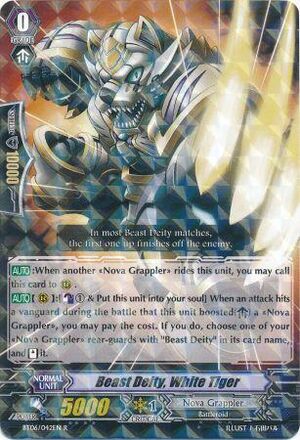
Hello everyone, a game I recently got into has quickly become my favorite card game. That is Card Fight Vanguard. We have some people in the academy that play it and we thought of extending it to have its own section here. As the DA banner says "Children's card game school", we should extend to just more than Yu-Gi-Oh. And here I bring you, a gigantic article on how to play Vanguard.
Chapter 1: The Beginning
Vanguard originated in Japan and was created by Bushiro, the same people that made Weiss Schwarz. The game is much similar with some same aspects like damage, triggers and other mechanics. Vanguard quickly became a huge success in America. It is a very simple but intense game, using strategies and out playing your opponent to win. Separating decks by clans, it becomes very organized and very fun.
Chapter 2: Learning about the terms
In Vanguard, a card looks much different than a Yu-Gi-Oh card. I'll be using proper terms which I will list
Vanguard Term List
Vanguard: Your starting unit, this unit is always on your field at the start and end of the game and cannot be removed from the field.
Rear-Guard: In Vanguard, the field has 6 spots. The upper center spot is for the vanguard, and the rest are for the rear-guards. The front row rear guards can make attacks just like the vanguard can while the back row units are there for boosting your attacking units.
Grade: Basically the level of a unit, it goes from 0-3 with 0 being either your triggers or your starting vanguard.
Unit: What Yu-Gi-Oh calls monsters, we call units. You can call as many units as you want in a turn as long as it's under 5.
Riding: This is the first thing you do after you draw. When you start a game, your starting vanguard is at grade 0, to ride, you place a grade 1 unit on the vanguard. Whatever the grade of your vanguard is, is the grade of units you can call or less. So if my vanguard is at grade 2, I can call grade 2 or less units to my field. You do this once per turn.
Calling: Basically putting units on the field that isn't on your vanguard spot.
Triggers: Triggers are put into 4 catagories, heal, critical, draw and stand. You are only allowed to play 4 heal triggers in a deck and have a maximum of 16 triggers in your deck. All triggers are grade 0 and do varying things. Each trigger has a symbol to tell you what kind of trigger it is.
Damage: Damage can only happen when a unit successfully hits the vanguard. To do damage, you take the top card of your deck and put it into your damage zone face-up. Once you have a total of 6 damage, you lose the fight.
Blocking: When your unit or vanguard is being attacked, you have the option to block. On the right side of cards grade 2 or less, will be a number either "0", "5,000" or "10,000". For example if the opponent attacks with a rear-guard with 14,000 power and he's attacking my vanguard which is at 8,000, I have the option to block, when blocking, you have to have more block than the attack power of the attacking unit. So I have to block with a 10,000 shield in order to block the attack.
Drive Checking: This is only for the vanguard, when a vanguard attacks another vanguard, no matter if they block or take the damage, the attacking vanguard always drive checks. This is when you reveal the top card of your deck. now basing on what you revealed, is what happened. So say I reveal a trigger, all triggers apply 5,000 to the unit of choice and have a secondary feature. Critical triggers give the unit of choice a +1 which means if the attack is successful, it deals 2 damage instead of 1. Draw triggers apply 5,000 and then you draw a card, Stand triggers stand a unit of choice and Heal triggers if you have more damage than the opponent, you take out 1 card from the damage zone and put it in the drop zone. Cards that are "Drive checked" go to the hand.
Drop Zone: Basically the graveyard of Vanguard. rear-guards that are attacked and not blocked, cards used to block, rear-guards that are retired and other effects that some cards do are put here.
The different grade icons
Now in Vanguard, under every single grade number is an icon. All grades 0 and 1 have the same icon, all grade 2's have the same icon and all grade 3's have the same icon.
Grade 0 and 1 icon (Booster): This icon means that if this unit is tapped along with a unit infront of it, the unit applies its power to the attacking unit.
For example if my vanguard has 10,000 power but has a unit behind it that is a grade 0 or 1 and is tapped when the vanguard attacks. the vanguard gets the units power as well, so say the unit was 8,000. The total power of my attacking vanguard is 18,000.
Grade 2 Icon(Intercepting): All grade 2's have this. When they are put on the front row rear-guard circles, that means they can use this ability. So say my opponent attacks my vanguard and I don't have enough block power to stop it. What I can do is take my grade 2's on the rear-guard spots and use them as block as well. All grade 2's have 5,000 shield so the block is counted for as well.
Grade 3 Icon(Twin Drive): This ability only happens when you have a grade 3 vanguard. When the vanguard drive checks, the player reveals 1 card and puts it in his hand. But with twin drive, you drive check 2 cards. Remember rear-guards don't drive-check so this is only for the vanguard. All trigger power can be distributed to the front row to whatever the player chooses.
Chapter 3: Learning about the card

Let's use this card for an example. Let's take the terms we just learned and show you where they are.
The top left, the number 0 is the grade. Under that, the symbol for "Booster". Under that where it says shield, is the amount of shield is put into the blocked units power. The amount of text is the effect of the card. (We will learn more about that later). Under that is the name and type of unit the card is (Normal or Trigger unit). Then under the unit type is the number 5,000. That is the amount of power the unit has. On the right is a symbol of a star and 1, that's how much damage the unit does when it attacks. To the right of that is the type of thing the card is and the clan it belongs to. So this is a starting vanguard for Nova grapplers. "The type of card doesn't really mean anything". If this was a trigger unit, it would have a symbol to the top right. For example down below.
 This is a heal trigger, notice the green symbol in the top right.
This is a heal trigger, notice the green symbol in the top right. This is a draw trigger, notice the brownish red symbol in the top right.
This is a draw trigger, notice the brownish red symbol in the top right. This is a critical trigger, notice the yellow symbol in the top right.
This is a critical trigger, notice the yellow symbol in the top right. This is a stand trigger, notice the blue symbol in the top right.
This is a stand trigger, notice the blue symbol in the top right.Chapter 4: How to Ride
In Vanguard, riding is a crucial part of the game, without riding, you can't call more powerful units or twin drive. So here is a run-down on how to ride the vanguard.
Note: You can only ride the vanguard and nothing else. Once you draw a card for your turn, you go into the Ride phase, this is where you increase the grade of your vanguard. Also, only cards of the same clan can ride the vanguard. A royal Paladin cannot ride a great nature vanguard.

So for example this card.


Notice how both cards are "Nova Grapplers". A card with a different clan cannot ride our example. So the ride phase happens once per turn, once it's your turn again, you would ride a grade 2 Nova Grappler over the grade 1 and then next turn, ride a grade 3. You can also ride units with the same grade as the vanguard, for example a grade 1 over a grade 1. If you do not have the next grade number so if you can't ride a grade 2 over a grade 1 because you don't have a grade 2 in the hand, this is called Grade stuck and it is the worst part about Vanguard.
So next part, we'll learn about the different clans and also start learning about the different effects like counter-blasting and soul charging, till next time guys, see ya.


